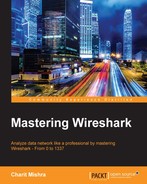TCP is a reliable form of communication that has features like a three-way handshake and a tear down process ensures the connection is reliable and interactive.
A TCP header is 20 bytes long and consists of various fields such as source and destination port, SEQ and ACK numbers, offset, window size, flag bits, checksum, and options. The presence of various flags and header fields let the sender and receiver be sure about the delivery as well as the integrity of the data being sent.
The SEQ and ACK numbers are used by TCP-based communications to keep track of how much data is being sent across between the hosts taking part.
A UDP is a connection-less protocol that is a nonreliable means of communication over IP, where the lost and discarded packets are never recovered. A UDP does provide us with faster transmission and easier creation of sessions. A UDP header is 8 bytes long, which has very few fields such as source and destination port, packet length, and checksum. At the end application, the data is appended.
Common protocols such as DHCP, TFTP, DNS, and RTP mostly use a UDP as a transport mechanism, and these services are some of the major services that we deal with in our everyday life. To make the connection reliable, some of these protocols support their own version of acknowledging features that comes inbuilt.
In the next chapter, you will learn the basics of wireless traffic, how to decrypt wireless traffic, and the anomalies that may follow.
